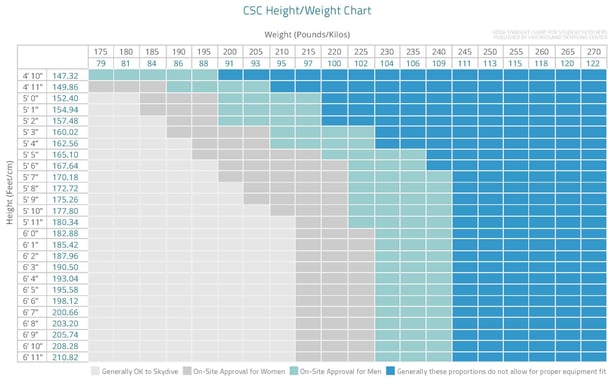Many people wonder: is there a weight limit for tandem skydiving? The answer is yes.
But why? Well, there are a few answers to that question, and we will explain them here.
Most skydiving centers will say their weight limit for a tandem passenger is approximately 200-220 pounds for women and 230-250 pounds for men. There is typically no minimum weight, only a minimum age (18 years old in the US). But there's more to it than the number on the scale.
Some dropzones have “heavy” upcharges built into their pricing model - basically charging heavier customers more ($1 per pound above 220lbs is a common example). Policies like this are not meant for “fat-shaming,” but instead directly related to how much more work (and the associated higher pay rate for the instructor) is required to take that person on a successful skydive.
At Chicagoland Skydiving Center, we have found that most people that fall within the approved sections of our skydiving weight limit chart (shown below) can be safely accommodated on a skydive. Most respected skydive companies will operate within similar thresholds.

Sometimes, we have to make on-site assessments of potential tandem jumpers. This is sometimes necessary for guests on the higher end of the allowable weight spectrum. In these situations, we must test out harness fit, and see the student demonstrate the strength to pick up their feet while in a seated position for landing.
It’s our responsibility as skydiving experts to assess potential safety concerns, and the last thing we want to do is make someone feel bad about their body. So, we want to explain the factors that influence our decisions.
So why is there a skydiving weight limit?
Tested Equipment Limits
The manufacturer of the skydiving equipment defines the limits for its use. For the equipment we use at CSC, the total weight of the tandem pair using the system must not exceed 500 pounds. (That means the weight of the student, plus the weight of the instructor, plus the weight of the gear combined). All the components and the final rig design goes through rigorous testing before released to the market and must receive at TSO (Technical Standard Order) from the Federal Aviation Administration. The weight limit helps keep tandem skydiving consistently operating within the known tested limits of the gear.
Tandem Harness Fit
When you make a tandem skydive, you are outfitted with a harness that is designed to adjust to fit a wide range of body types. But, there is a limit to how far straps and pads can go and stay properly secured. If we aren’t able to achieve a proper harness fit on the ground, it could cause catastrophic problems in the sky. Our height/weight chart offers one way to set expectations about who can safely use the tandem harness.
Parachute Performance Range
While it’s certainly more technical, parachutes are essentially a fancy arrangement of nylon and strings. Needless to say, there are limits to how well they can perform when pushed to the limits of weight suspended underneath. A proper deployment sequence and manageable flight is only possible with reasonable weight in the harness below it. The instructor’s ability to steer and control the parachute decreases the more weight it is carrying. The strength needed to “flare” the parachute (a maneuver essential to landing) increases substantially with a heavier passenger.
Because both people must be considered when it comes to tandem jump weight, consider what must happen as the student gets bigger/heavier….the instructor must get smaller/lighter. Have you ever tried to steer a snow sled or kayak with someone nearly twice your size on the front? It’s not easy! Consider how much is being asked of a 150 pound instructor to control and land a parachute safely with a 245 pound passenger attached to his chest.
Physical Strength for Landing Position
There are several ways to perform a parachute landing, but the most consistently successful method involves the tandem student lifting his or her legs up in front of the body while in the seated position in the harness. This “legs up” position must be held for the final 5-10 seconds of flight, so it becomes less likely that feet and ankles touch down first, which could topple the tandem pair forward or put extreme strain on the lower limbs. This can be more difficult for people without the necessary core strength, or a belly that gets in the way. This limitation is simply more common for people falling outside the pre-approved sections of the height/weight chart.
Sometimes it helps to get an outside expert perspective on these types of issues, so we talked with our good friend Tom Noonan, the Director of the Tandem Skydiving Program for United Parachute Technologies. This is the company that manufactures the world’s best tandem skydiving systems, the gear we use at CSC. Tom helps manage the training of skydiving instructors, accountability to standards, and overseeing how tandem skydiving equipment is used all over the world. Tom visits CSC regularly to train our staff, to host standardization meetings for tandem instructor examiners, and sometimes, even to skydive for fun!
Bottom line: skydiving is an extreme sport. We like to have fun, and in some cases the risk simply becomes too great to make it enjoyable. Our safety approach is really about limiting risk factors as much as possible. Weight limit and body profile assessments are simply one of the ways we do that.
While other dropzones may have a different weight policy than we use at CSC, we hope this information helps answer many of the common questions about this issue.
Still have questions about being able to jump with us? Feel free to contact our Customer Care team to discuss this issue further.


